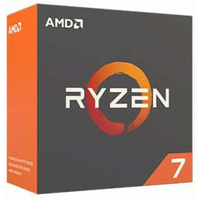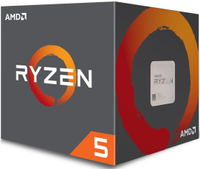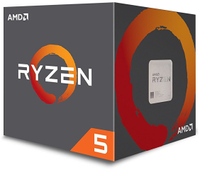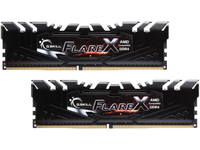Extreme Overclocking: 10 Ryzen CPUs Under LN2
Introduction
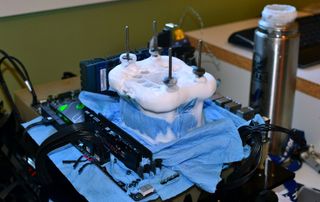
AMD's Ryzen processors offer a compelling price/performance ratio right out of the box. But despite their many overclocking-friendly knobs and dials, most enthusiasts struggle to take the CPUs beyond 4 GHz. Given that we know the ins and outs of extreme overclocking, though, we have a solution. It's time to break out the liquid nitrogen!
Allow us to take you on a cryogenic journey, where we'll explore Ryzen's behavior when it's cooled to -196°C. Our experiment will allow us to correlate frequency scaling to temperature, voltage, and core count. We also have some tips on hardcore modding, such as lapping (sanding smooth) the processor.
| Note that we previously published an article on overclocking Ryzen using air and water cooling. Check out How To Overclock AMD Ryzen CPUs for more. |
If, after reading through everything, you have questions about your own overclocking endeavors, don't hesitate to ask them in our comments section. We'll be keeping an eye out in order to help however possible.
Test Configuration
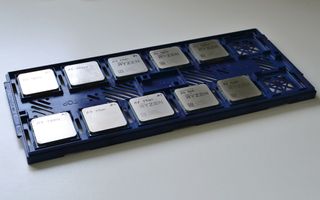
We don't want to limit our quest to just one sample, or even one model. Thanks to AMD's generosity, we were able to get our hands on every SKU in the Ryzen family. Here's what we have access to for today's overclocking adventure:
- 2x Ryzen 7 1800X
- 1x Ryzen 7 1700X
- 3x Ryzen 7 1700
- 1x Ryzen 5 1600X
- 1x Ryzen 5 1600
- 1x Ryzen 5 1500X
- 1x Ryzen 5 1400
The processors used for this test are different than the chips used for our previous article on overclocking with air and water cooling. Therefore, we expect to see different results.
In the interest of truly torturing these CPUs, we surrounded ourselves with some of the best hardware available for testing:
The motherboard we're using is Asus' Crosshair VI Hero, equipped to facilitate extreme overclocking. The only feature it's missing is a second BIOS, which could have come in useful for recovering from a corrupted configuration.
Stay on the Cutting Edge
Join the experts who read Tom's Hardware for the inside track on enthusiast PC tech news — and have for over 25 years. We'll send breaking news and in-depth reviews of CPUs, GPUs, AI, maker hardware and more straight to your inbox.
This ROG-series motherboard is armed with two sticks of G.Skill Flare X DDR4 memory. These modules were specially developed for Ryzen. Furthermore, they are equipped with Samsung B-die ICs, known for their overclocking headroom.
Last of all, we use a Cooler Master MasterWatt Maker 1200 power supply.
MORE: Best CPUs
MORE: How To Overclock AMD Ryzen CPUs
MORE: De-Lidding and Overclocking Core i7-7700K
MORE: CPU Overclocking Guide: How (and Why) to Tweak Your Processor
-
InvalidError It isn't surprising that the highest-end CPUs have the highest and least troublesome overclocks as that's what chip binning is for - the best dies go to the premium SKUs first, lower tiers get what is left over.Reply -
-Fran- Reply19937674 said:It isn't surprising that the highest-end CPUs have the highest and least troublesome overclocks as that's what chip binning is for - the best dies go to the premium SKUs first, lower tiers get what is left over.
Even more, it's very interesting since it gives some credibility that AMD is not binning due to defects, but electrical properties, hence, making the rumour mill of being able to unlock some 4C and 6C to higher core counts not that far-fetched.
Cheers! -
Wisecracker Très bon!Reply
(hope I used this correctly)
Just wondering ... would it be considered a 'faux pas' (or, an insult to AMD) to release the batch numbers?
-
theyeti87 Reply19937697 said:19937674 said:It isn't surprising that the highest-end CPUs have the highest and least troublesome overclocks as that's what chip binning is for - the best dies go to the premium SKUs first, lower tiers get what is left over.
Even more, it's very interesting since it gives some credibility that AMD is not binning due to defects, but electrical properties, hence, making the rumour mill of being able to unlock some 4C and 6C to higher core counts not that far-fetched.
Cheers!
Wasn't that a similar case with the Phenom X4, X3, and X2's? Or were those 3's and 2's disabled cores due to defect? -
-Fran- Reply19937706 said:19937697 said:19937674 said:It isn't surprising that the highest-end CPUs have the highest and least troublesome overclocks as that's what chip binning is for - the best dies go to the premium SKUs first, lower tiers get what is left over.
Even more, it's very interesting since it gives some credibility that AMD is not binning due to defects, but electrical properties, hence, making the rumour mill of being able to unlock some 4C and 6C to higher core counts not that far-fetched.
Cheers!
Wasn't that a similar case with the Phenom X4, X3, and X2's? Or were those 3's and 2's disabled cores due to defect?
They were a mix of both. If you were lucky (and could track down some of the batches) you were able to unlock the CPU with little worry, but there were defective ones that when unlocked, would not work. I came across both myself.
To be honest, I just catalog it as "interesting", because I will pay the difference to always get the full working version, but I do know there's people out there that like gambling and can track batch numbers :P
Cheers! -
InvalidError Reply
The relatively low defect rate has been a given since launch IMO: half of each CPU core is L2 cache and half of the CCX die area is the L3, so you have a 50% chance that defects within a CCX will land in L3. If the defect rate had been significant, cache defects would have forced AMD to launch models with 8MB of L3 long before the 1400.19937697 said:Even more, it's very interesting since it gives some credibility that AMD is not binning due to defects, but electrical properties -
-Fran- Reply19937880 said:
The relatively low defect rate has been a given since launch IMO: half of each CPU core is L2 cache and half of the CCX die area is the L3, so you have a 50% chance that defects within a CCX will land in L3. If the defect rate had been significant, cache defects would have forced AMD to launch models with 8MB of L3 long before the 1400.19937697 said:Even more, it's very interesting since it gives some credibility that AMD is not binning due to defects, but electrical properties
True. It's just nice to have more non-validated statistical-irrelevant proof! Haha.
Cheers! :P -
Gregory_3 This is all kind of cute, but the real market success will be played out in conventional liquid cooled and air cooled environments. Nobody is going be running high end software with condensation dripping all over.Reply -
InvalidError Reply
There wouldn't be condensation issues if OCers used the nitrogen gas boiling out of the pot to displace air and the moisture it contains around the motherboard to keep it off of it. Instead of circulating the boil-off around the motherboard though, LN2 OCers use fans to suck it away, drawing more moisture-ladden air in the area.19938043 said:Nobody is going be running high end software with condensation dripping all over.
-
gasaraki "It isn't surprising that the highest-end CPUs have the highest and least troublesome overclocks as that's what chip binning is for - the best dies go to the premium SKUs first, lower tiers get what is left over."Reply
While it might not be surprising, it shows the immaturity of the Ryzen processors in that the build quality is not the same between different CPUs or even CCXes and binning is what they do for the lower cored versions. If your build process was mature ALL your chips would come out mostly the same and "awesome" then at that point your forced to just shutdown cores to make the lower cored processors.
Most Popular



